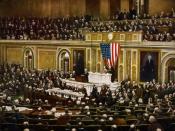Following the maelstrom of violence that was the First World War, the United States retreated into a protective shell of isolationism. This is seen most through comparing the rampant international meddling that took place in the period 1900-1919 with the tariffs and political isolation that was the norm of the 1920s.
In the first two decades of the twentieth century, the US acted as a world power. They played both sides in World War I until they finally joined the Allies side. After their victory in World War I, President Wilson pushed his 14 Points on Europe, fundamentally dictating the resolution of the war to European leaders. With the assistance of other European leaders, Wilson essentially redrew the borders of Europe.
The US also took a very active political role in South America. Between 1900 and 1920, for example, the United States intervened in six Western Hemispheric nations, establishing protectorates in Haiti and the Dominican Republic, and periodically stationing U.S.
Marines in Nicaragua. In 1867 the United States pressured the French into removing troops supporting the Emperor Maximillian in Mexico. In the 1910s, however, as part of an ill-starred campaign to influence the Mexican revolution, the United States found itself sending an army of 11,000 troops into the northern part of the country in a futile effort to capture the elusive rebel and outlaw Pancho Villa. The US also worked with Columbian rebels to create Panama, so that the US could construct the Panama Canal, after the Columbian Congress refused to ratify the US' treaty in 1903. Overall, the US took a very active role in global politics up through World War I.
However, after World War I, the US's position changed radically: the American people had had enough of involvement and decided that isolationism was the way to...



Ok
great start, conclusion is kind of weak;
a few more specific examples (or quotes) would be nice, especially about the WWI treaties.
0 out of 0 people found this comment useful.